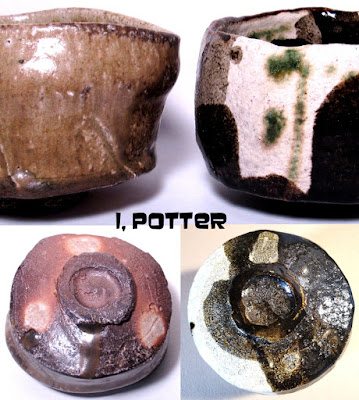Illustrated are two uniquely different chawan, almost as different as night and day though linked through the commonality of purpose, size, form and of course the necessity of a foot. On the left is a well fired Iga chawan with a great presence, a casual posture and just the right amount of "wonkiness" to captivate the eye and underneath the chassis is a very well cut kodai that not only is a perfect fit but it is pleasing to the eye and hand as well. The chawan on the right is a fun, almost playful hikidashi-guro chawan that obviously takes its cues from modern Oribe pottery at some level and like the Iga chawan, the kodai is very well matched to the chawan in both spirit and purpose. As disparate as this two chawan are, there is an even greater connection between them, they were both created by the same potter, Kojima Kenji who created these two unique styles and forms and made a somewhat similar style kodai match perfectly despite all the differences in form and surface. As I have mentioned, I love a really good chawan with an equally good kodai, I enjoy the enthusiasm of the process and the finished effort, the spirit of the creative solution and boundaries that can be pushed at, stretched and warped a bit and in the end be mindful to a function that goes back to the earliest pots ever created, does the pot work?
Wednesday, June 2, 2021
TIMES TWO (X2)
Now
I love drippy ash and unctuous Shino, thick fractured celadon, large, wonky
forms, brazen postures and forms but when I turn that chawan over and find a
brilliant kodai that is well beyond the perfunctory and is devoid of flash and
gimmick, quite frankly, I am really happy! A kodai that has true purpose and is
distinctly creative that completes a form should be a given as a feature of a
360º, six sided object and anything less just takes away from what could have
otherwise been a rather nice bowl. I have never really considered myself a
"foot" person but over several decades it has become perfectly clear
just how absolutely essential the skill of creating a good kodai really is and
how many potters abdicate their responsibility for expediency and economy of
time and simplicity of form. A good kodai
takes time, effort and lots and lots of practice where learning the mastery of
throwing a bowl may only take several years, the foot can take a lifetime of
evolving, mastering the art of removing, sculpting and crafting that creates an
element that is not only complimentary but serves its "prime
directive" of function is a delicate process despite how seemingly brutal
the actual cutting and creative process can be.
Subscribe to:
Comments (Atom)
